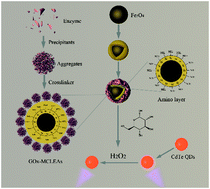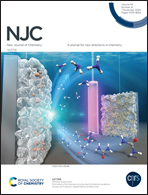Fluorescent biosensor based on magnetic cross-linking enzyme aggregates/CdTe quantum dots for the detection of H2O2-bioprecursors†
Abstract
The sensing method for hydrogen peroxide could also be employed to detect H2O2-bioprecursors in the presence of oxidase. However, the sensitivity of the conventional method is limited, and the catalytic stability and recyclability of enzymes also need to be improved. In this study, glucose was chosen as a typical representative H2O2-bioprecursor to design a fluorescence sensing system for H2O2-bioprecursors based on a magnetic immobilized enzyme and CdTe quantum dots. The magnetic immobilized enzyme was fabricated by a cross-linking method to enhance the stability and recyclability of the enzyme. The obtained product was characterized by scanning electron microscopy, transmission electron microscopy, energy dispersive spectrometry, and vibrating sample magnetometry, respectively. The CdTe quantum dots were prepared by a hydrothermal method, and revealed a maximum emission peak at about 610 nm under the maximum excitation light (339 nm). The developed CdTe QDs exhibited excellent sensing performance for hydrogen peroxide. The prepared immobilized enzyme and quantum dots were used to develop a fluorescence sensing system and were successfully exploited to detect a typical H2O2-bioprecursor (glucose) in the presence of glucose oxidase. The method exhibited good linear performance in the concentration range of 1–20 μg mL−1, and good recoveries ranging from 106.2–117.7%. This study demonstrated that the strategy could be extended to detect more H2O2-bioprecursors.



 Please wait while we load your content...
Please wait while we load your content...